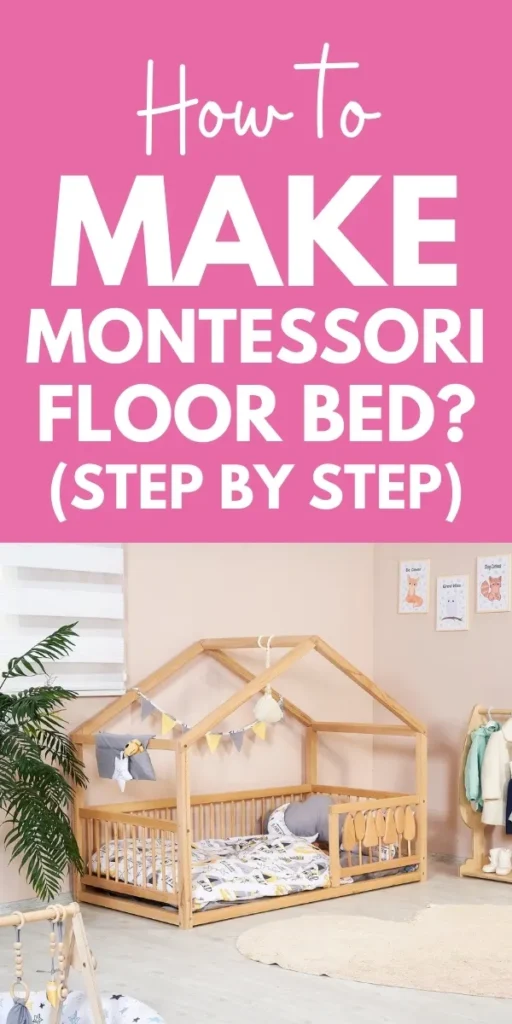In the world of Montessori education, the environment plays a crucial role in nurturing a child’s independence and fostering a love for learning.
One key element in creating this environment is the Montessori floor bed, a low-profile sleep solution that empowers your little explorer to navigate their world with ease and confidence.
But how do you build this essential piece of furniture and bring the Montessori philosophy into your child’s bedroom? Let’s learn “how to build a montessori floor bed” and explore the steps to creating a safe and serene haven for your little one.
Understanding the Montessori Philosophy: Why the Floor Bed Matters
The Montessori method emphasizes freedom of movement and independence. Unlike traditional cribs, which confine children, a floor bed allows them to climb in and out on their own, fostering a sense of control and responsibility for their sleep environment.
This freedom also encourages exploration, allowing them to wander around their room and engage with their surroundings at their own pace.
benefits of a Montessori floor bed:
- Boosts self-confidence and independence: Climbing in and out of bed independently builds confidence and a sense of accomplishment.
- Promotes a sense of security and comfort: A low-to-the-ground bed creates a safe and cozy environment, reducing anxiety around bedtime.
- Encourages exploration and discovery: The freedom of movement allows children to explore their room and interact with their environment more freely.
- Facilitates easier nighttime transitions: Children can easily get out of bed when they need to use the restroom, reducing the need for parental intervention.
Planning Your DIY Floor Bed: Choosing Materials and Design
Crafting a floor bed is a rewarding experience that allows you to personalize the sleep space to your child’s needs and preferences. Here’s what you need to consider:
Materials:
- Wood: Choose sturdy, untreated wood like pine, poplar, or plywood for a safe and durable bed frame.
- Mattress: Opt for a low-profile mattress specifically designed for floor beds to ensure comfort and safety.
- Hardware: Screws, dowels, and other fasteners suitable for wood construction.
- Optional: Fabric for curtains, paint for personalization, or decorative accents.
Design:
- Size: Measure your child’s mattress and add a few inches for overhang. Standard twin mattresses are a good starting point.
- Height: Aim for a height that allows your child to comfortably climb in and out, typically around 12-18 inches.
- Style: Choose a simple, minimalist design that aligns with the Montessori philosophy and complements your child’s room decor.
- Safety features: Ensure the bed has rounded edges and no sharp corners to prevent injuries. Consider adding guardrails for younger children if needed.
Building Dream Bed (For Your Child): Step-by-Step Guide

With your plan in place, it’s time to get your hands dirty! Here’s a basic guide to building your child’s Montessori floor bed:
Tools:
- Saw (circular saw or miter saw recommended)
- Drill
- Screwdriver
- Sandpaper
- Measuring tape
How To Build A Montessori Floor Bed
- Cut the wood pieces: Based on your design and measurements, cut the wood pieces for the bed frame (headboard, footboard, side rails).
- Pre-drill holes: Drill pilot holes to prevent the wood from splitting when screwing the pieces together.
- Assemble the frame: Join the wood pieces using screws or dowels, ensuring a sturdy and secure structure.
- Sand the edges: Smooth out any rough edges to prevent splinters.
- Attach the mattress support: Install slats or a platform to support the mattress securely.
- (Optional) Add finishing touches: Paint, decorate, or add curtains to personalize the bed.
Remember: This is a basic guide, and you can customize the design and construction based on your skills and preferences. Always prioritize safety and ensure the bed is sturdy and secure before letting your child sleep in it.
Additionally, the floor bed promotes:
- Improved sleep quality: Feeling safe and secure can lead to deeper sleep and fewer nighttime wake-ups.
- Increased physical development: Climbing in and out of bed strengthens gross motor skills and coordination.
- Enhanced creativity and imagination: The freedom of movement encourages imaginative play and exploration within the bedroom space.
- A stronger bond between parent and child: Respecting your child’s autonomy and independence fosters a sense of trust and strengthens your relationship.
Remember, building a Montessori floor bed is not just about carpentry; it’s about creating an environment that embodies the Montessori philosophy of respect, independence, and self-discovery.
This simple change can have a profound impact on your child’s development, fostering a lifelong love of learning and a sense of empowerment that will stay with them long after they transition to a traditional bed.
So, grab your tools, unleash your creativity, and embark on the journey of crafting a sleep space that empowers your little one to dream big and explore the world with confidence.
